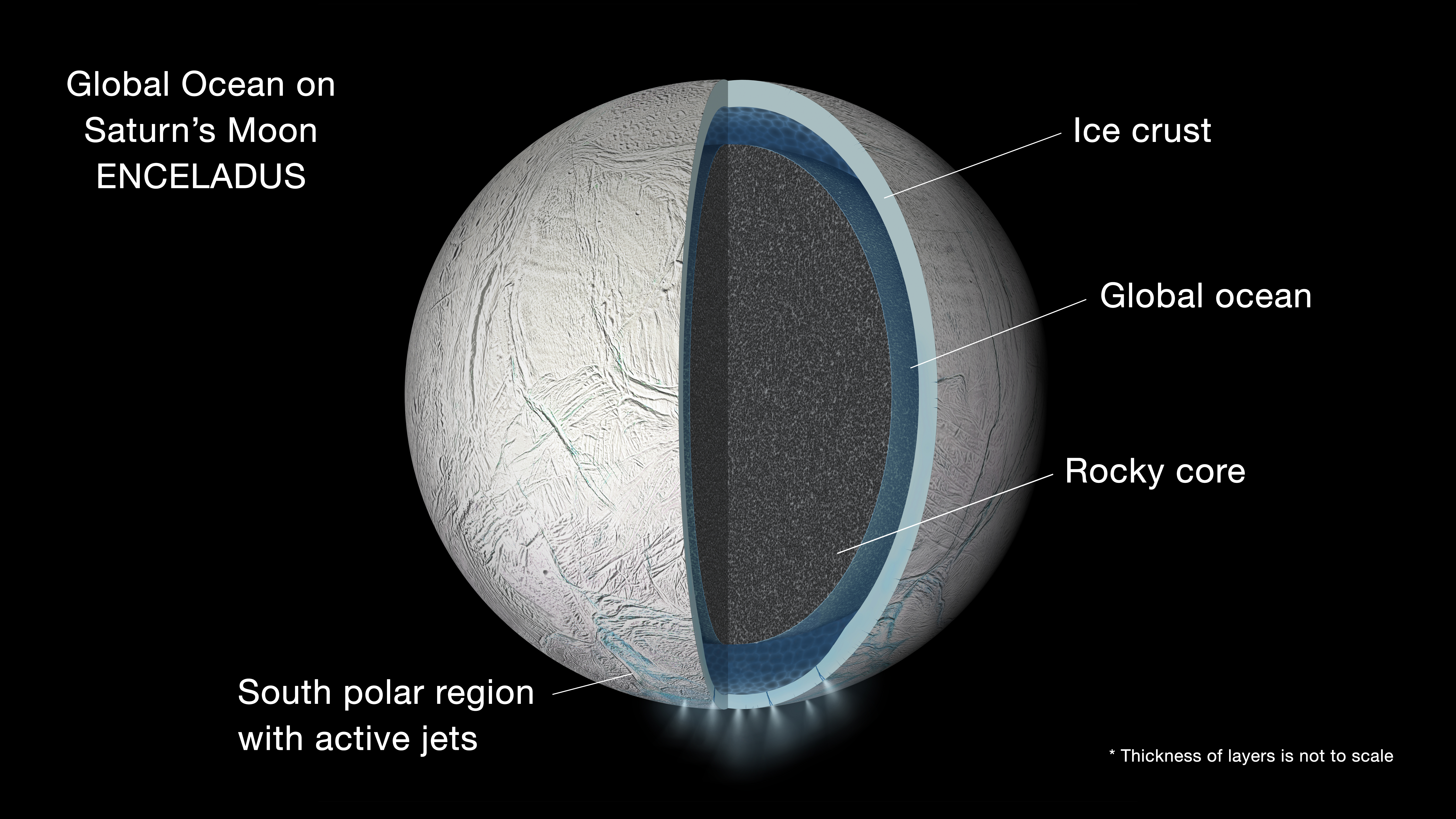Researchers have made a groundbreaking discovery on Saturn’s moon, Enceladus.
What is discovery?
Utilising data from NASA’s Cassini mission, they have identified hydrogen cyanide—a vital building block for life—within the colossal plumes of water vapour and ice grains ejected by the moon.
While earlier known that these plumes contained organic compounds crucial for life, this new finding adds a significant layer to our understanding of the potential for life-sustaining energy sources on Enceladus.
Wait…is there another discovery?
Yes!
In addition to disclosing hydrogen cyanide, scientists have announced another intriguing aspect of Enceladus. Beneath its icy exterior lies a concealed ocean responsible for generating the plumes. Moreover, this ocean has been identified as a potent reservoir of chemical energy.
Previously undiscovered, this energy source manifests in the form of various organic compounds—some of which function as fuel for living organisms on our home planet, Earth.

These groundbreaking findings, published in Nature Astronomy, on December 14, suggest that Enceladus harbours a considerably more significant amount of chemical energy than initially estimated. The significance lies in the direct correlation between the abundance of power and the likelihood of life flourishing and persisting. This revelation opens up new avenues for exploring the potential habitability of this seemingly modest moon.
Why are these discoveries on Saturn important?
Lead author Jonah Peter, a doctoral student from Harvard University who conducted a significant portion of the research at NASA’s Jet Propulsion Laboratory in Southern California, emphasised the implications of their work.
“Our work provides further evidence that Enceladus is host to some of the most important molecules for both creating the building blocks of life and sustaining that life through metabolic reactions,” he said.
According to Peter, the moon meets the fundamental criteria for habitability. It offers insights into the potential formation of complex biomolecules and the underlying chemical pathways. This knowledge marks a significant step in understanding the conditions that could support life beyond Earth.

Peter expressed his enthusiasm about the discovery of hydrogen cyanide, noting its pivotal role in theories about the origins of life. He explained, “The significance lies in that hydrogen cyanide is the starting point for most hypotheses on the emergence of life. Life, as we understand it, relies on essential building blocks like amino acids, and hydrogen cyanide stands out as a crucial and adaptable molecule in forming amino acids.”
Describing it as the “Swiss army knife of amino acid precursors,” Peter highlighted the versatility of hydrogen cyanide, as its molecules can be arranged in various ways to contribute to amino acid formation. He emphasised the robustness of their findings, noting that rigorous testing of alternative models only strengthened the evidence, ultimately concluding that hydrogen cyanide is an indispensable component of the moon’s plume composition.
In 2017, scientists identified promising chemistry at Enceladus that could potentially support life within its hidden ocean. The presence of carbon dioxide, methane, and hydrogen in the plume hinted at methanogenesis—a metabolic process responsible for methane production. This process is not only typical on Earth. Still, it is also believed to be pivotal in our planet’s early stages of life.
The recent study delves even more deeply, uncovering evidence of additional and more potent chemical energy sources beyond methane production. The researchers detected various oxidised organic compounds, suggesting diverse chemical pathways that could sustain life in Enceladus’ subsurface ocean. The significance lies in the role of oxidation. This process facilitates the release of chemical energy, providing a broader understanding of the moon’s potential habitability.
What is Cassini?
The Cassini spacecraft is a joint endeavour involving NASA, the European Space Agency (ESA), and the Italian Space Agency.
Setting off on its journey in 1997 alongside ESA’s Huygens probe, Cassini didn’t just head directly to Saturn. It took a detour to study Jupiter for six months in 2000. Finally arriving at Saturn in 2004, Cassini embarked on a captivating exploration, treating us to a celestial tour of Saturn’s varied moons through a series of flybys.

One standout juncture in Cassini’s experience was in the same year it arrived at Saturn when it released the Huygens probe onto Titan, one of Saturn’s moons. This mission offered an in-depth look at Titan’s atmosphere and surface composition.
As Cassini entered its second extended mission, it achieved remarkable feats. It made history by capturing the first observations of an entire seasonal cycle for Saturn and its moons.
Cassini also flexed its celestial muscles, daringly navigating between Saturn’s iconic rings and descending into the planet’s atmosphere. It has provided unparalleled data, enriching our cosmic understanding of the Saturnian system.
Cassini’s extraordinary 20-year mission ends, leaving a trail of remarkable achievements. From flawlessly executing 2.5 million commands and covering an impressive 4.9 billion miles since its 1997 launch to amassing 635 gigabytes of science data and capturing 453,048 images, the spacecraft has rewritten the narrative of Saturn and its moons. Six previously unnamed moons, 294 orbits, and 162 targeted flybys later, Cassini’s legacy extends beyond scientific discovery, embodying the collaborative spirit of 27 nations.











